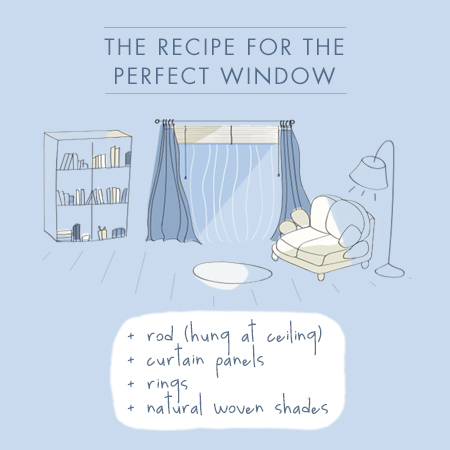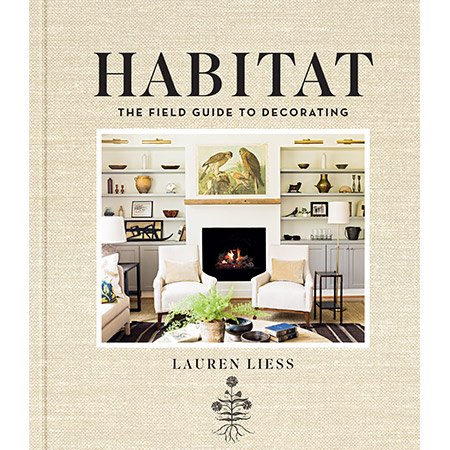The Recipe for the Perfect Window
Interior designer Lauren Liess answers all your window-treatment questions—from what the perfect curtain length and lining are to what hardware to use—in her book, Habitat: The Field Guide to Decorating.

Photo: Helen Norman
I believe the indoor-outdoor connection in a home is vital, and because windows and doors are that gateway, the type of window treatment, if any, to be used in a room is an important consideration. If a view is stunning, the window itself is beautiful, there is no need for privacy, and the room itself feels warm enough and isn't lacking in fabrics, I will forgo window treatments. It's not often, however, that all these stars align, so I'm also a fan of classic, simple window treatments: curtain panels with rods and rings, Roman shades, roller shades, and shutters.
I use floor-to-ceiling curtain panels in most cases because they make the room feel taller and airier, they add a beautiful layer of fabric in a room, and they can also make up for lackluster architecture. The curtain fabrics and the style of curtain panel, the pleating, trim, and hardware all affect the level of formality in a room. Pleated curtains are more formal, whereas straight panels are more casual. Likewise, lined silk and velvet curtains feel the most formal, whereas unlined linens and cottons are casual.
Calculating Panel Widths
One of the trickiest things to calculate is the proper number of panel widths for a window. Standard single-curtain panel widths are approximately fifty inches, because most fabric comes fifty-four inches wide, which allows for seaming. You should be able to pull two curtain panels easily shut without their going taut. On a typical thirty-three-inch-wide window, use a pair of double-width (one hundred inches of fabric) pleated panels or two single-and-a-half-width (seventy-five inches of fabric) non-pleated panels for a full look. The guidelines to the left will help you calculate required panel widths, and are based on non-pleated panels. For pleated panels, add an extra half panel (twenty-five inches) to full panel (fifty inches) for every single panel of width.
Guidelines for non-pleated/ flat-panel width
20"–30" Windows: a pair of single panels, 50 inches each
30"–48" Windows: a pair of 1.5' or double panels, 75 to 100 inches each
48"–84" Windows: a pair of double panels, 100 inches each
84"–144" Windows: a pair of triple panels, 150 inches with possible quadruple panels (200 inches) if a fuller look is desired
Curtain Length
A tailored curtain should just touch, or "kiss," the floor but never hover above it. For a slightly less tailored look, allow a two- to four-inch break of curtain fabric on the floor. For a romantic look, allow the panels to go even longer so that they puddle on the floor.
To Line or Not to Line?
For lighter-colored fabrics that aren't at risk of fading, I often specify unlined curtains, which have a casual, relaxed, airy feel. For bright or saturated colors, and especially silks or velvets, to protect against fading from the sun, it's safest to use blackout lining behind the fabrics. Be sure to keep curtains clear of dust, with regular shaking out and/or vacuuming, because the sun on the dust particles can make the fabric brittle very quickly. A lined curtain feels more formal, whereas an unlined curtain is casual.
Curtain Hardware
For curtain hardware, I typically like the emphasis to be on the fabric rather than the hardware, so I use simple, thin rods and rings in both formal and casual homes. On flat, non-pleated panels, I like ten rings per panel, and on pleated panels, I prefer seven rings per single panel.
Roman Shades
Roman shades, which fold into themselves, can be made from fabric or natural woven materials. Roman shades work beautifully on their own—in kitchens, bathrooms, and children's rooms—as well as in conjunction with curtains for a pretty, layered look. When ordering, specify “inside mount” for shades that will mount inside the window frame, and "outside mount" for those that will mount on or outside the window frame. When the woodwork on a window frame is particularly interesting or beautiful, I opt for inside mount shades. If the woodwork is nothing to speak of or I'm worried about blocking light, I specify outside mount shades, because they can be affixed to the trim or even higher to reduce the amount of shade that blocks the window when the shade is up. I frequently use natural woven shades or matchstick shades to bring an additional natural element to a room. Unlined matchstick shades filter light nicely but are see-through at night, so if privacy is needed, line them.
Roller Shades
Roller shades are ideal for a simple, no-fuss look. They work well alone or paired with curtains. These use inside mounts.
Shutters
Shutters can offer a fresh, clean look. They're also ideal in spaces where moisture might become an issue for fabrics, such as bathrooms. Indoor shutters have louvers that can open and close; though, even when the louvers are open, your view to the outdoors is generally inhibited.
Wooden Blinds
Wooden blinds are ideal for areas in which little ornamentation is needed and they should be inset into the window. They can be pulled up so that the view out the window is completely unhindered and pulled down for complete privacy.

My go-to window treatment entails mounting curtain hardware at the ceiling or just under the crown molding. Roman shades should hang just below that hardware, mounted above the window and outside the trim; outside mount to allow as much of the window as possible to show and to give the illusion that the window continues higher, which visually heightens the entire room. This treatment is both functional and beautiful, because the curtain panels remain stationary, while the Roman shades go up and down for privacy, and you now have two opportunities to add texture and pattern to a room instead of just one. I'm especially partial to unlined linen curtains; I love how the light shines through them and how relaxed and natural they look.

Text excerpted from Habitat: The Field Guide to Decorating. Copyright © 2015 by Lauren Liess. Reproduced by permission of Abrams.
I use floor-to-ceiling curtain panels in most cases because they make the room feel taller and airier, they add a beautiful layer of fabric in a room, and they can also make up for lackluster architecture. The curtain fabrics and the style of curtain panel, the pleating, trim, and hardware all affect the level of formality in a room. Pleated curtains are more formal, whereas straight panels are more casual. Likewise, lined silk and velvet curtains feel the most formal, whereas unlined linens and cottons are casual.
Calculating Panel Widths
One of the trickiest things to calculate is the proper number of panel widths for a window. Standard single-curtain panel widths are approximately fifty inches, because most fabric comes fifty-four inches wide, which allows for seaming. You should be able to pull two curtain panels easily shut without their going taut. On a typical thirty-three-inch-wide window, use a pair of double-width (one hundred inches of fabric) pleated panels or two single-and-a-half-width (seventy-five inches of fabric) non-pleated panels for a full look. The guidelines to the left will help you calculate required panel widths, and are based on non-pleated panels. For pleated panels, add an extra half panel (twenty-five inches) to full panel (fifty inches) for every single panel of width.
Guidelines for non-pleated/ flat-panel width
20"–30" Windows: a pair of single panels, 50 inches each
30"–48" Windows: a pair of 1.5' or double panels, 75 to 100 inches each
48"–84" Windows: a pair of double panels, 100 inches each
84"–144" Windows: a pair of triple panels, 150 inches with possible quadruple panels (200 inches) if a fuller look is desired
Curtain Length
A tailored curtain should just touch, or "kiss," the floor but never hover above it. For a slightly less tailored look, allow a two- to four-inch break of curtain fabric on the floor. For a romantic look, allow the panels to go even longer so that they puddle on the floor.
To Line or Not to Line?
For lighter-colored fabrics that aren't at risk of fading, I often specify unlined curtains, which have a casual, relaxed, airy feel. For bright or saturated colors, and especially silks or velvets, to protect against fading from the sun, it's safest to use blackout lining behind the fabrics. Be sure to keep curtains clear of dust, with regular shaking out and/or vacuuming, because the sun on the dust particles can make the fabric brittle very quickly. A lined curtain feels more formal, whereas an unlined curtain is casual.
Curtain Hardware
For curtain hardware, I typically like the emphasis to be on the fabric rather than the hardware, so I use simple, thin rods and rings in both formal and casual homes. On flat, non-pleated panels, I like ten rings per panel, and on pleated panels, I prefer seven rings per single panel.
Roman Shades
Roman shades, which fold into themselves, can be made from fabric or natural woven materials. Roman shades work beautifully on their own—in kitchens, bathrooms, and children's rooms—as well as in conjunction with curtains for a pretty, layered look. When ordering, specify “inside mount” for shades that will mount inside the window frame, and "outside mount" for those that will mount on or outside the window frame. When the woodwork on a window frame is particularly interesting or beautiful, I opt for inside mount shades. If the woodwork is nothing to speak of or I'm worried about blocking light, I specify outside mount shades, because they can be affixed to the trim or even higher to reduce the amount of shade that blocks the window when the shade is up. I frequently use natural woven shades or matchstick shades to bring an additional natural element to a room. Unlined matchstick shades filter light nicely but are see-through at night, so if privacy is needed, line them.
Roller Shades
Roller shades are ideal for a simple, no-fuss look. They work well alone or paired with curtains. These use inside mounts.
Shutters
Shutters can offer a fresh, clean look. They're also ideal in spaces where moisture might become an issue for fabrics, such as bathrooms. Indoor shutters have louvers that can open and close; though, even when the louvers are open, your view to the outdoors is generally inhibited.
Wooden Blinds
Wooden blinds are ideal for areas in which little ornamentation is needed and they should be inset into the window. They can be pulled up so that the view out the window is completely unhindered and pulled down for complete privacy.

My go-to window treatment entails mounting curtain hardware at the ceiling or just under the crown molding. Roman shades should hang just below that hardware, mounted above the window and outside the trim; outside mount to allow as much of the window as possible to show and to give the illusion that the window continues higher, which visually heightens the entire room. This treatment is both functional and beautiful, because the curtain panels remain stationary, while the Roman shades go up and down for privacy, and you now have two opportunities to add texture and pattern to a room instead of just one. I'm especially partial to unlined linen curtains; I love how the light shines through them and how relaxed and natural they look.

Text excerpted from Habitat: The Field Guide to Decorating. Copyright © 2015 by Lauren Liess. Reproduced by permission of Abrams.



